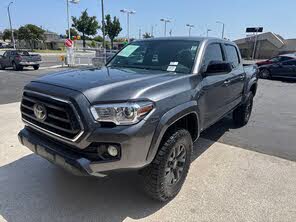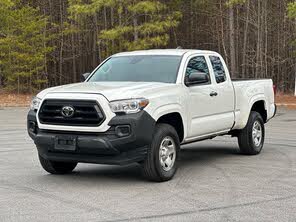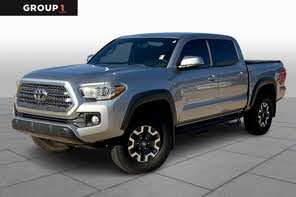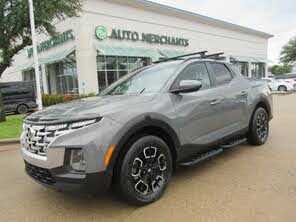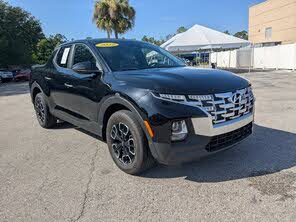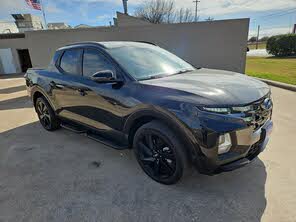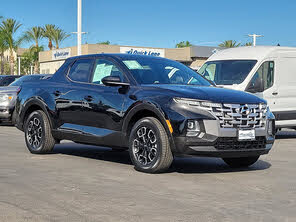Toyota Tacoma vs Hyundai Santa Cruz
Overview | |
Years produced1995-Present | Years produced2022-Present |
MSRP$31,500 | MSRP$26,900 |
Listings9557 | Listings8073 |
Ratings & Reviews | |
User Reviews | User Reviews |
Expert reviews7.8 out of 10 | Expert reviews7.8 out of 10 |
Pros
| Pros
|
Reviews SummaryThe fourth-gen Tacoma is also the first Tacoma to share a platform with the larger Toyota Tundra. (The TNGA-F platform also underpins the Sequoia and the just-revived Land Cruiser.) It launches in six trim levels, each powered by a turbocharged four-cylinder engine, and the Tacoma's first-ever hybrid powertrain is due in the spring of 2024, along with two additional trims. We traveled to Malibu, CA to drive the all-new Tacoma in all of its gas-only guises. | |
Reviews SummaryThe Hyundai Santa Cruz has been a favorite since its debut in 2021 for the 2022 model year. And what’s not to love? It’s got plenty of utility for its size, it sports a peppy powertrain, and it’s all wrapped up in a quirky package. There are a few new additions for 2024, but by and large this is the same Santa Cruz we’ve come to know and love. | |
No video found | |
Popular Features & Specs | |
Engine2.4L 228 hp I4 | Engine2.5L 191 hp I4 |
Drive Train4X2 | Drive TrainFWD |
Seating Capacity2 | Seating Capacity5 |
Horsepower228 hp @ 6000 rpm | Horsepower191 hp @ 6100 rpm |
MPG City20 | MPG City22 |
MPG Highway26 | MPG Highway26 |
Engine | |
Engine Name2.4L 228 hp I4 | Engine Name2.5L 191 hp I4 |
Torque243 lb-ft @ 1600 rpm | Torque181 lb-ft @ 4000 rpm |
Horsepower228 hp @ 6000 rpm | Horsepower191 hp @ 6100 rpm |
Drivetrain4X2 | DrivetrainFWD |
Fuel Economy | |
MPG City20 | MPG City22 |
MPG Highway26 | MPG Highway26 |
Interior | |
Seating Capacity2 | Seating Capacity5 |
Safety | |
Front Crash Overall | Front Crash Overall5 |
Side Crash Overall | Side Crash Overall5 |
Dimensions & Capacity | |
Bed Length73.5 in | Bed Length52.1 in |
Curb Weight4145 lbs | Curb Weight3755 lbs |
Height74.0 in | Height66.7 in |
Length213.0 in | Length195.7 in |
Width76.9 in | Width75.0 in |
Wheelbase131.9 in | Wheelbase118.3 in |
Maximum Payload1460 lbs | Maximum Payload1701 lbs |
Number of doors2 | Number of doors4 |
Maximum Towing Capacity3500 lbs | Maximum Towing Capacity3500 lbs |
Standard Towing Capacity3500 lbs | Standard Towing Capacity |
Overview | ||
Years produced | 1995-Present | 2022-Present |
MSRP | $31,500 | $26,900 |
Listings | ||
Ratings & Reviews | ||
User reviews | ||
Expert reviews | 7.8 out of 10Read full review | 7.8 out of 10Read full review |
Pros & cons | Pros
| Pros
|
Summary | The fourth-gen Tacoma is also the first Tacoma to share a platform with the larger Toyota Tundra. (The TNGA-F platform also underpins the Sequoia and the just-revived Land Cruiser.) It launches in six trim levels, each powered by a turbocharged four-cylinder engine, and the Tacoma's first-ever hybrid powertrain is due in the spring of 2024, along with two additional trims. We traveled to Malibu, CA to drive the all-new Tacoma in all of its gas-only guises. | The Hyundai Santa Cruz has been a favorite since its debut in 2021 for the 2022 model year. And what’s not to love? It’s got plenty of utility for its size, it sports a peppy powertrain, and it’s all wrapped up in a quirky package. There are a few new additions for 2024, but by and large this is the same Santa Cruz we’ve come to know and love. |
Video | No video found | |
Popular Features & Specs | ||
Engine | 2.4L 228 hp I4 | 2.5L 191 hp I4 |
Drive Train | 4X2 | FWD |
Seating Capacity | 2 | 5 |
Horsepower | 228 hp @ 6000 rpm | 191 hp @ 6100 rpm |
MPG City | 20 | 22 |
MPG Highway | 26 | 26 |
Engine | ||
Engine Name | 2.4L 228 hp I4 | 2.5L 191 hp I4 |
Torque | 243 lb-ft @ 1600 rpm | 181 lb-ft @ 4000 rpm |
Horsepower | 228 hp @ 6000 rpm | 191 hp @ 6100 rpm |
Drivetrain | 4X2 | FWD |
Fuel Economy | ||
MPG City | 20 | 22 |
MPG Highway | 26 | 26 |
Interior | ||
Seating Capacity | 2 | 5 |
Safety | ||
Front Crash Overall | 5 | |
Side Crash Overall | 5 | |
Dimensions & Capacity | ||
Bed Length | 73.5 in | 52.1 in |
Curb Weight | 4145 lbs | 3755 lbs |
Height | 74.0 in | 66.7 in |
Length | 213.0 in | 195.7 in |
Width | 76.9 in | 75.0 in |
Wheelbase | 131.9 in | 118.3 in |
Maximum Payload | 1460 lbs | 1701 lbs |
Number of doors | 2 | 4 |
Maximum Towing Capacity | 3500 lbs | 3500 lbs |
Standard Towing Capacity | 3500 lbs | |
Though it was all-new, the 2024 Toyota Tacoma did not represent a shocking stylistic departure from its predecessor. This apple fell close enough that there was no mystery as to which tree it came from. The new hexagonal grille lent it a meaner, more menacing countenance, and the overall look leaned blockier and more angular, but the familiar Toyota truck look remained. 17-inch “steelies” were standard for the base SR trim, replaced by 17-inch alloy wheels for most or 18-inch alloys for TRD Sport and Limited.
Updates were more noticeable inside, where the aesthetic made a significant shift that appeared to have been influenced by the Ford F-Series. The distinct areas of the dash were now squared off rather than demarcated by organic lines, and the gear shift knob was a bulky, geometric affair. If that weren’t enough to remind driver and passengers that they were in a truck, the MOLLE panels placed strategically throughout the cabin served to emphasize a function-over-form approach. Even the Limited trim, which came standard with heated and ventilated SofTex-trimmed seats, sported large and obvious plastic grids inside the doors and along the console, where one might expect to see soft-touch materials in models topping competing ranges. Perhaps the hybrid-only Trailhunter and TRD Pro would rectify this, but then again, perhaps not, as the point of the MOLLE panels was to provide plenty of spots to affix accessories, a clear priority of Toyota trucks.
The compact Santa Cruz wasn’t technically a pickup truck. It was a unibody crossover with a small bed plonked onto the rear. The trucklette was available in SE, SEL, Night, or the new XRT trims, but our tester was the tippy-top Limited trim.
The Santa Cruz was about 14 inches longer overall than the Hyundai Tucson, but the two vehicles shared similar front ends, complete with the cool Tron-looking grille. Every design element looked intentional, from the protruding fenders to the sharply raked C-pillar. If you wanted to blend in at the drive-through, this probably wasn’t the vehicle for you.
The inside was neither particularly luxurious nor noticeably sparse, although the four-spoked steering wheel was a funky design choice. Materials looked and felt high-quality for the Santa Cruz's price point, and we spotted no problems with fit and finish. Even the plastics felt good when touched. A thin horizontal bar of trim spanned driver and passenger space, clearly delineating the two. That trim continued on to each upper door panel as well for a cohesive look.
For 2024, the Tacoma became all-turbo, all the time: The 2.4-liter turbocharged four-cylinder engine (branded "i-FORCE") was standard and produced 278 horsepower and 317 pound-feet of torque on most trims. It was tuned for 228 hp and 243 lb-ft of torque in the base Tacoma SR, still far exceeding the 159 hp and 180 lb-ft the base 2023 Tacoma mustered. Both rear-wheel drive (RWD) and four-wheel drive (4WD) were available, but we got to drive only 4WD models at launch.
An eight-speed automatic transmission replaced the outgoing six-speed auto, and we found it to work well in the time we spent driving various trims on the roads of Malibu. Shifts were smooth and felt appropriately timed, and while we did experience a bit of turbo lag when stomping on the gas from a stop or a crawl, we noted no delay changing gears at highway speeds. There was still a six-speed manual transmission available as well, but we had very little time with it and as of right now, could only comment that the bite point was awfully high, making it a bit of a pain to manage when maneuvering in a busy parking lot or in three-point turns.
One guiding principle for the new Tacoma, according to Toyota, was differentiation among the trims. Each was supposed to have its own identity and fit-for-purpose character, and Toyota really dove into this goal by engineering multiple suspensions for the various options. The new coil spring multi-link rear suspension came on all but the SR, Double-Cab SR5, and TRD Pre-Runner, which still featured leaf springs in the rear. But even among those that benefited from the new rear suspension, components and tuning differed from trim to trim. The Tacoma TRD Sport’s shocks were sport-tuned, for example, while the TRD Off-Road got monotube Bilstein shocks. An adaptive variable suspension could be optioned on the top Limited trim, and it did make a noticeable difference in ride comfort. In general, though, we found the new Tacoma’s on-road manners unobjectionable in each configuration.
Maximum capability was reserved for the i-Force Max hybrid powertrain, which Toyota was still keeping close to the vest as of this writing. We could report that the TRD Pro got FOX QS3 adjustable internal bypass shocks and that the Trailhunter boasted Toyota’s first partnership with Old Man Emu, an Australian aftermarket company known for off-road- and overlanding-capable applications.
Other updates for this next-gen Tacoma included newly standard disc brakes and newly standard electric power steering, replacing the rack-and-pinion power steering system of the previous generation. In addition to allowing for additional driver-assistance features, the new steering system seemed to have effectively addressed the vagueness of the outgoing model.
While you could get any trim with either front-wheel drive (FWD) or all-wheel drive (AWD), lower Santa Cruz trims were available with only a naturally aspirated 2.5-liter four-cylinder engine good for 191 horsepower and 181 pound-feet of torque. This engine was mated to a traditional eight-speed automatic transmission. We hadn’t had a chance to sample it, but the Santa Cruz SE and SEL weighed right around 3,750 pounds and the non-turbo engine might have felt a bit underpowered.
Instead, our tester was fitted with a turbocharged engine, upping the power to 282 hp and 311 lb-ft of torque. Power went to all four wheels through an eight-speed dual-clutch transmission. This powertrain was surprisingly peppy, allowing for easy passing, even uphill. The transmission offered smooth shifts and drivers could take advantage of the paddle shifters for more control.
The ride quality was also excellent, soaking up rough pavement easily. However, it was really the maneuverability of the Santa Cruz that made it stand out. Even the smallest midsize truck could be a pain to park in tight spaces, but the reduced footprint of the Santa Cruz made it a great city car. It could navigate indoor parking garages easily and zip through heavy traffic just as easily as a car.
Of course, you may have wanted to take your Santa Cruz out and do some off-roading. Hyundai campaigned the Santa Cruz in the Rebelle Rally, a seven-day off-road navigational motorsports event, and it made it through with only slight modifications. You’d definitely want to swap out the Michelin Primacy all-season rubber for something more aggressive, but the AWD system featured a center locking differential to split the power evenly front to rear for better off-road performance. There was even hill-descent control, although it could be a bit too quick depending on the steepness of the hill. Keeping your foot over the brake was advisable, just to be safe.
You’d also want to protect the underbody of the Santa Cruz if you ventured far afield. Ground clearance was similar to other compact crossovers—8.6 inches—but the geometry was pretty terrible. Approach, departure, and breakover angles sat at 17.5 degrees, 23.2 degrees, and 18.6 degrees respectively. In all, your best bet was to keep to gravel roads unless you liked going really, really slowly.
Toyota did away with the punitively small rear seats of the previous generation: The Access Cab was no more. Replacing it was a new two-door configuration called “XtraCab.” There were no clamshell doors or pretensions to extra seating here; instead, Toyota committed to treating the area behind the front seats as cargo space, providing lockable storage on the floor and on the back panel. This space was supposed to be easily accessible thanks to the driver’s seat’s long slide path, but in the two-door SR5 we tested, we still struggled to fold the manual-adjust front seat forward enough to reach our belongings on the driver’s side. We did find it easier to maneuver backpacks out of the cargo area around the passenger’s seat, which folded flat to form a work surface that contractors operating solo out of an XtraCab Tacoma would likely have found handy.
We also had the opportunity to test several four-door Double Cab models, including the gas Tacoma's top Limited trim. Without the hassle of manually adjusting the front seats, we were able to appreciate the additional comfort of the updated seat shape, which felt like a significant upgrade to us. Head- and legroom figures were nearly identical for 2024, with the Double Cab handing off just over an inch of legroom from the front to the back row (it now had 41.8 inches of legroom up front and 33.7 in the back, compared to 42.9 and 32.6 in the previous year). Toyota noted that gas-powered four-door Tacoma models now had three times more storage capacity beneath the flat-folding rear seats than the outgoing Tacoma offered, a welcome update.
Toyota continued to offer a choice of 5-foot or 6-foot bed for the four-door Tacoma, though the XtraCab was available only with the larger bed. A 440-watt outlet was available on gas models, and hybrid Tacomas came with a 2400-watt version. The bed depth from rail to deck had been increased, raising total bed volume by seven percent and allowing a camp fridge to fit beneath the optional tonneau cover. Camp fridges were among the Tacoma accessories available from Toyota dealers, which also included rooftop tents, high-lift jacks, and wireless trailer cameras.
Some folks may have eschewed the Santa Cruz for not being a true pickup truck, but the truth was this little guy had all the utility most shoppers needed. In AWD form, the Santa Cruz had a towing capacity of 5,000 pounds, albeit with a braked trailer. A FWD Santa Cruz could tow 3,500 pounds with a braked trailer. If your trailer didn’t have integrated brakes, Hyundai recommended keeping the load to just 1,650 pounds.
Cargo hauling in the tiny bed was pretty robust. The bed measured 52 inches long and nearly 54 inches wide, although there was only 43 inches between the wheel wells. To give you an idea of how much space that was, we went camping and hauled a shade canopy, two chairs, an air compressor, two Maxtrax recovery boards, a cot, a tent, a sleeping bag, and recovery gear in the bed with no problem.
There was lockable underfloor storage as well as two little cubbies in the side of the bed for smaller items. Our tester came with multiple tie-down points and sliding rail anchors. Hyundai said total payload was 1,411 pounds across all trims.
Covering the bed was a sliding and locking tonneau cover, great for keeping things out of sight when parked. However, the latch on our tester seemed a bit finicky. It often felt like it was going to break when moving it to the open position. All trims got a dampened tailgate and side steps in the rear bumper to easily access cargo.
Inside, the rear seats folded up to haul taller items, which was pretty cool. However, legroom in the rear was just 36.5 inches. That might have seemed like a good amount, but remember, this thing was bigger than a Tucson which had over 41 inches of rear legroom.
One detail we must mention was the heated front seats. They didn’t mess around, heating up to nearly scalding temperatures. Fortunately, there were three levels of adjustability, so drivers could keep their rear ends from overheating. This feature was on all but the base model. However, if you wanted ventilated seats, you’d have to pony up for the top Santa Cruz Limited trim. These worked well, although they didn’t offer hiney-freezing temperatures.
If the six domains of the CarGurus test drive review were competing for superlatives, Technology would have won “most-improved” for the Tacoma. For 2023, the truck came with a base 7-inch touchscreen or an available 8-inch. Now, 8 inches was the standard size, and higher trims got a massive 14-inch center display which took up nearly as much visual real estate as the steering wheel did. Both screens ran the latest version of Toyota’s Audio Multimedia system, which was responsive and legible, if a tad low on ornamentation. (Toyota’s minimalist approach to infotainment graphics hadn’t bothered us when viewed recently on other Toyota and Lexus screens, but the inherent white space was made starkly obvious when splashed across the larger display.)
Wireless Apple CarPlay and Android Auto were standard, and a Qi wireless charging pad could be added along with the dual front-row USB-C charging ports. If optioned, the charging pad was positioned conveniently, angled for phone stability and perfectly visible to the driver. Some other automakers had overdone efforts to engineer a usable charging pad. Toyota forwent such gimmicky solutions but did take some leaves from its competitors’ books. The optional 10-speaker JBL sound system, for example, incorporated a removable portable speaker which sat flush with the dash when functioning as a part of the system but could be removed at the push of a button to serve independently as a water-resistant Bluetooth speaker, giving the Jeep Gladiator a run for its tailgate-vehicle money. The influence of Ford’s F-150 Raptor could be seen, too, in the optional pre-wired auxiliary switches. If added, these allowed the driver to operate up to three accessories via the buttons located to the left of the steering wheel.
Those considering the 2024 Taco for towing may have been interested in the newly available trailer brake controller, which could work in concert with the Panoramic View Monitor (if optioned) to add a compatible trailer’s perspective to the blind-spot monitoring system. A wireless trailer camera accessory was also available to help with towing and hauling.
SE and SEL trims came with an 8-inch touchscreen running Hyundai’s BlueLink infotainment system. This may have been the better option as it supported wireless Apple CarPlay and Android Auto. The upper trims got a larger 10.25-inch display which for some reason offered only wired smartphone compatibility.
On the whole, the infotainment system was easy to use and intuitive, with quick reaction times and clear graphics. However, there was no physical volume knob. Drivers had to use the steering wheel control or a touch-sensitive button under the screen to change the volume of the available Bose premium audio system. It was fine but also a weird omission.
Aside from the volume control, there were also touch-sensitive buttons to access other stereo and media functions, the map and navigation, as well as the dual-zone automatic climate controls. Having physical buttons to quickly jump to a feature was great, but these icons were pretty tiny. If the driver’s finger didn’t hit the exact center of the button, it wouldn’t respond.
Charging was a bit sparse in the Santa Cruz, with just dual USB-A ports up front on all trim levels. Our Limited trim also got two USB-A ports for rear-seat passengers, but USB-C was not available. Wireless charging was standard on the top three trims and was available on the SEL but absent on the base SE trim.
With the newly standard electric power steering came safety technology that was new to the Tacoma lineup. The Tacoma still came standard with Toyota Safety Sense 3.0 (TSS 3.0), but that now included more active features such as Lane Tracing Assist (Toyota’s brand name for lane-centering), lane-departure alert with steering assist, and Proactive Driving Assist. All three fell on the more advanced and more interventional end of the spectrum of driver-assistance features, bringing the Tacoma along into the modern age of Level 2 autonomous driving aids.
Also new to the Tacoma for 2024 were road-sign assist and an emergency stop system which could slow the vehicle to a stop if it detected that the driver had become unresponsive while Lane Centering Assist was activated. While the Tacoma already had adaptive cruise control, that system had been enhanced to provide four choices of following distance rather than three. A blind-spot monitoring system with rear cross-traffic alert was standard on all but the base trim, to which it could be added as part of a package.
Hyundai offered a pretty comprehensive set of advanced driver-assistance systems. All trims got forward collision avoidance with pedestrian detection, blind-spot collision avoidance, rear cross-traffic collision avoidance, lane-keep assist and lane-following assist, safe exit warning, and rear occupant alert. XRT trim and above added adaptive cruise control and forward-collision avoidance with pedestrian, cyclist, and junction-turning detection, which helped deter accidents while turning left.
However, our Santa Cruz Limited tester got everything. Hyundai’s Highway Drive Assist paired adaptive cruise control and lane-centering to take some of the stress out of commuting. This was a hands-on/eyes-up system, however, and the driver had to pay attention at all times. The adaptive cruise control system also worked with the in-dash navigation system to slow for curves. Also here was the nifty blind-spot view monitor that displayed a side-view video in the gauge cluster when the turn signal was engaged. This was a wonderful feature that really showed the driver exactly what was or wasn’t in their blind spot.
CarGurus highlights

According to CarGurus experts, the overall rating for 2024 Toyota Tacoma is 7.8 out of 10, while the 2024 Hyundai Santa Cruz scores 7.8 out of 10. Given the equal ratings, the choice between these two vehicles depends on specific needs and preferences. If traditional truck attributes like towing capacity and rugged terrain handling are crucial, the Tacoma is the better choice. However, if a versatile, city-friendly vehicle that offers both utility and style is more appealing, the Santa Cruz holds significant allure. Each offers distinct advantages, making them top contenders in their respective niches.
Choose the 2024 Toyota Tacoma if:
- You value robust performance and off-road capability.
- You need a truck with versatile cargo solutions and towing capacity.
- Advanced safety and technology upgrades are a priority.
Choose the 2024 Hyundai Santa Cruz if:
- Maneuverability and style are important in urban settings.
- You prefer a vehicle that blends the comfort of an SUV with the utility of a truck.
- Advanced safety features are needed across all trim levels.According to CarGurus experts, the overall rating for 2024 Toyota Tacoma is 7.8 out of 10, while the 2024 Hyundai Santa Cruz scores 7.8 out of 10. Given the equal ratings, the choice between these two vehicles depends on specific needs and preferences. If traditional truck attributes like towing capacity and rugged terrain handling are crucial, the Tacoma is the better choice. However, if a versatile, city-friendly vehicle that offers both utility and style is more appealing, the Santa Cruz holds significant allure. Each offers distinct advantages, making them top contenders in their respective niches.
CarGurus highlights

According to CarGurus experts, the overall rating for 2024 Toyota Tacoma is 7.8 out of 10, while the 2024 Hyundai Santa Cruz scores 7.8 out of 10. Given the equal ratings, the choice between these two vehicles depends on specific needs and preferences. If traditional truck attributes like towing capacity and rugged terrain handling are crucial, the Tacoma is the better choice. However, if a versatile, city-friendly vehicle that offers both utility and style is more appealing, the Santa Cruz holds significant allure. Each offers distinct advantages, making them top contenders in their respective niches.
Choose the 2024 Toyota Tacoma if:
Shop Now- You value robust performance and off-road capability.
- You need a truck with versatile cargo solutions and towing capacity.
- Advanced safety and technology upgrades are a priority.
Choose the 2024 Hyundai Santa Cruz if:
Shop Now- Maneuverability and style are important in urban settings.
- You prefer a vehicle that blends the comfort of an SUV with the utility of a truck.
- Advanced safety features are needed across all trim levels.According to CarGurus experts, the overall rating for 2024 Toyota Tacoma is 7.8 out of 10, while the 2024 Hyundai Santa Cruz scores 7.8 out of 10. Given the equal ratings, the choice between these two vehicles depends on specific needs and preferences. If traditional truck attributes like towing capacity and rugged terrain handling are crucial, the Tacoma is the better choice. However, if a versatile, city-friendly vehicle that offers both utility and style is more appealing, the Santa Cruz holds significant allure. Each offers distinct advantages, making them top contenders in their respective niches.

By: CarGurus + AI
At CarGurus, our team of experienced automotive writers remain at the heart of our content operation, conducting hands-on car tests and writing insightful guides that are backed by years of industry experience. To complement this, we are harnessing AI to make our content offering more diverse and more helpful to shoppers than ever. To achieve this, our AI systems are based exclusively on CarGurus content, ratings and data, so that what we produce is both unique to CarGurus, and uniquely helpful to car shoppers.



